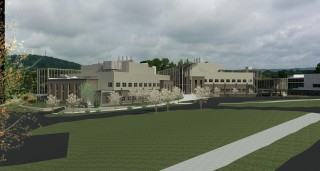Sep 1 2014
Binghamton University took a major step forward in its pursuit of path-breaking research on energy-efficient technologies with the start of construction on the University’s Smart Energy Research and Development Facility. On Wednesday, Aug.27, Binghamton University President Harvey Stenger was joined by Lt. Gov. Robert Duffy and other state and local officials at a groundbreaking ceremony for the new $70M, 114,000-square-foot building at the Innovative Technologies Complex, 85 Murray Hill Road, Vestal.
 Rendering of Binghamton University's new Smart Energy Facility which is scheduled for completion in 2017
Rendering of Binghamton University's new Smart Energy Facility which is scheduled for completion in 2017
The Smart Energy R&D Facility is a direct result of the NYSUNY 2020 plan approved by Gov. Andrew Cuomo and the Legislature in 2012. NYSUNY 2020 allowed the University to implement a rational tuition program which enabled the campus to embark on a plan for significant growth and pursue this new research facility.
“Our faculty members and graduate students are developing technologies that will change the way energy-efficient vehicles, devices and buildings are constructed in the future,” Stenger said. “Our researchers need world-class facilities to conduct their work, and that is what this Smart Energy R&D Facility provides. I want to thank Lt. Gov. Robert Duffy for joining us for this exciting event. I also want to thank Gov. Cuomo and our lawmakers, Sen. Thomas Libous and Assemblywoman Donna Lupardo, for working on our behalf and making it possible for the state to once again invest in Binghamton University.”
“Investing in our SUNY schools is the best way to ensure great things come out of them, and this new facility is an example of what we are doing to be more competitive and develop new technologies,” said Duffy. “Thanks to Gov. Cuomo’s vision for NYSUNY 2020, Binghamton University was given the tools to invest in its students’ future, leading the way for groundbreaking energy research and development. I applaud Binghamton University and all of our state partners for actualizing this facility, which will benefit the generations of students to come.”
“Whether it’s the University Downtown Center, the Innovative Technologies Complex, the new pharmacy school or the Southern Tier High-Technology Incubator, we're doing our best to maximize Binghamton University’s potential to be the economic powerhouse and career creator we need in our community,” said Libous.
“The Smart Energy Research and Development Facility will help Binghamton University researchers develop energy-efficient technologies that will have far-reaching impact well beyond this region and state,” Lupardo said. “It is my honor to have advocated for NYSUNY 2020 and this facility. It adds to the impressive Innovative Technologies Complex that we have been working on together for many years."
Smart The Energy R&D Facility will house Harpur College of Arts and Sciences’ physics and chemistry departments. The research that will continue in the new building focuses on:
- energy-efficient technologies
- making solar power economically competitive
- reducing and using the thermal energy generated by computers and other electronic devices
- developing mechanisms for the storage and transmission of energy through high-capacity batteries, fuel cells and ultra-capacitors
“The new building will also foster new partnerships with industry and provide faculty members working in this area with cutting-edge labs, state-of-the-art classrooms and integrated outreach offices,” said Anne McCall, dean of Harpur College of Arts and Sciences.
With a direct economic impact of $78.5 million on Broome and Tioga counties during its construction phase, the Smart Energy project will support more than 500 local jobs, including approximately 200 construction jobs. After construction, new employees will generate $2.5 million of economic impact annually to the local economy.
The brick, metal and steel two-story building will feature ornate custom steel in public areas as well as a green roof. Landscaping with natural stone walls and grading of the site will complement those of the adjacent Center of Excellence, Biotechnology, and Engineering and Science buildings.
LEED Platinum standards will be followed throughout construction – the highest certification possible and appropriate for a building dedicated to smart energy. Features will include micro turbines on mechanical systems, a fuel cell to produce electricity at a reduced cost to heat and cool the building, photovoltaic panels on the roof to produce electricity, hydronic radiant heating in the floor, controlled LED lighting, individual space monitoring of chemicals to reduce air flows and energy use, and water-cooled equipment wherever possible to conserve energy.
The building is scheduled for completion in 2017.